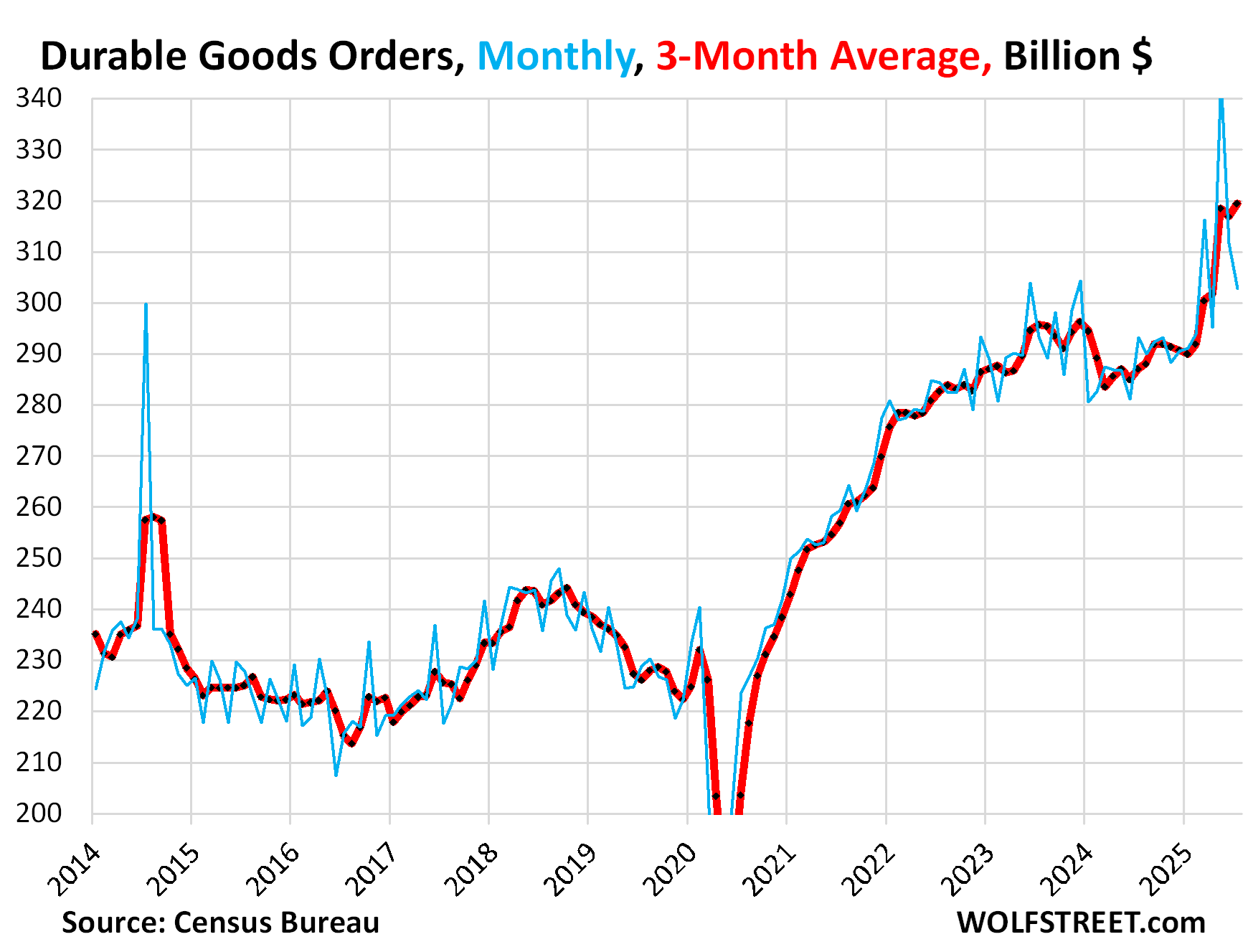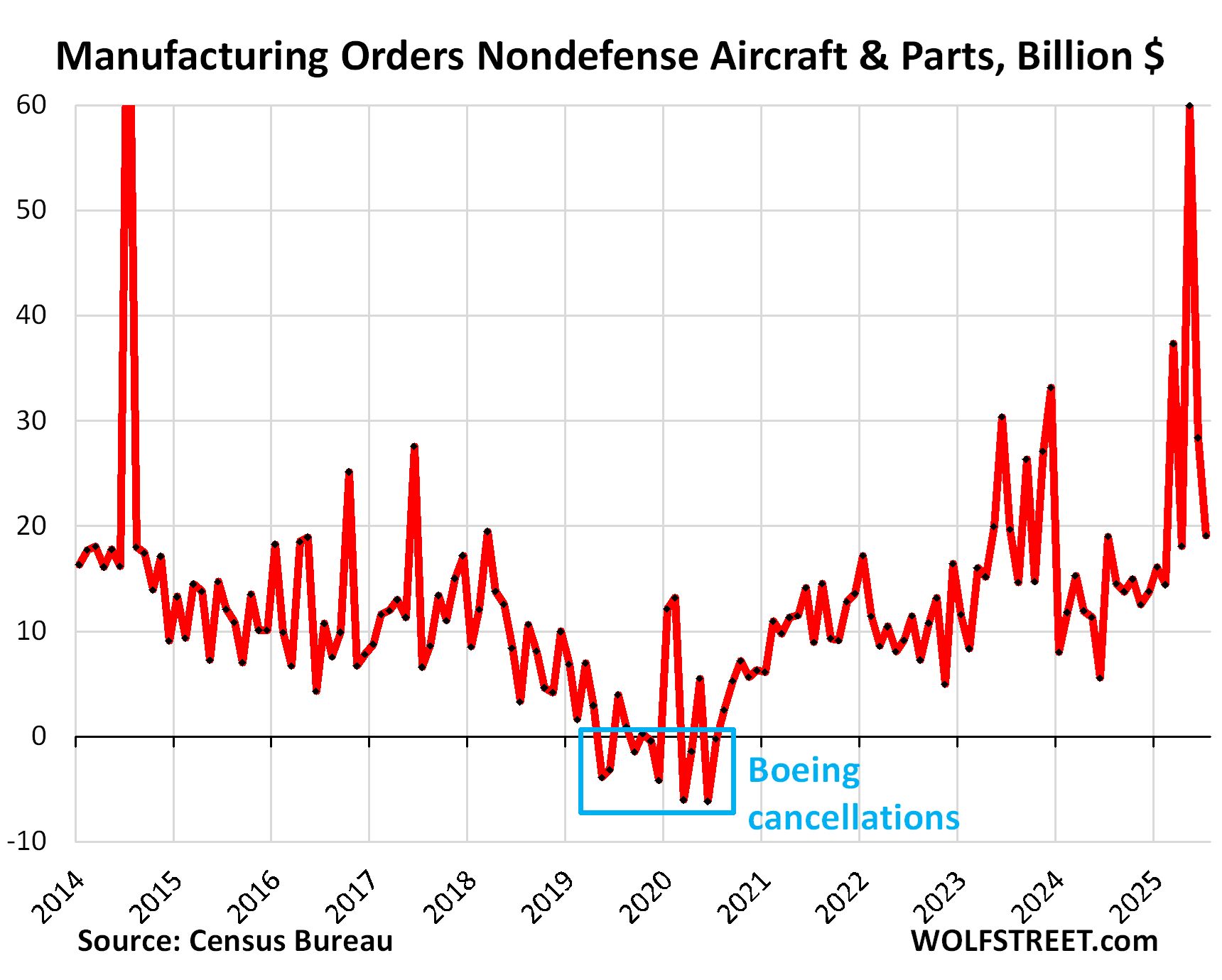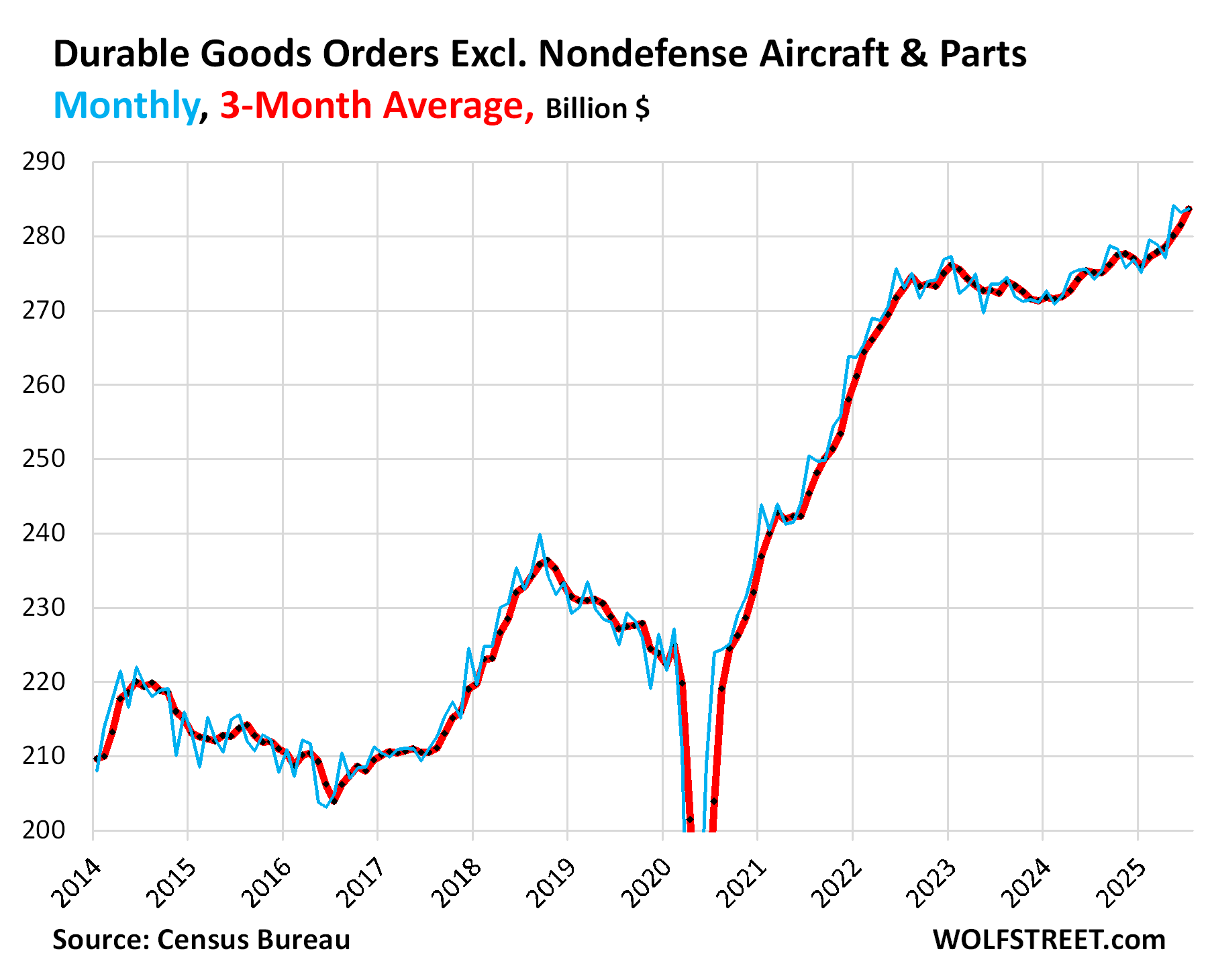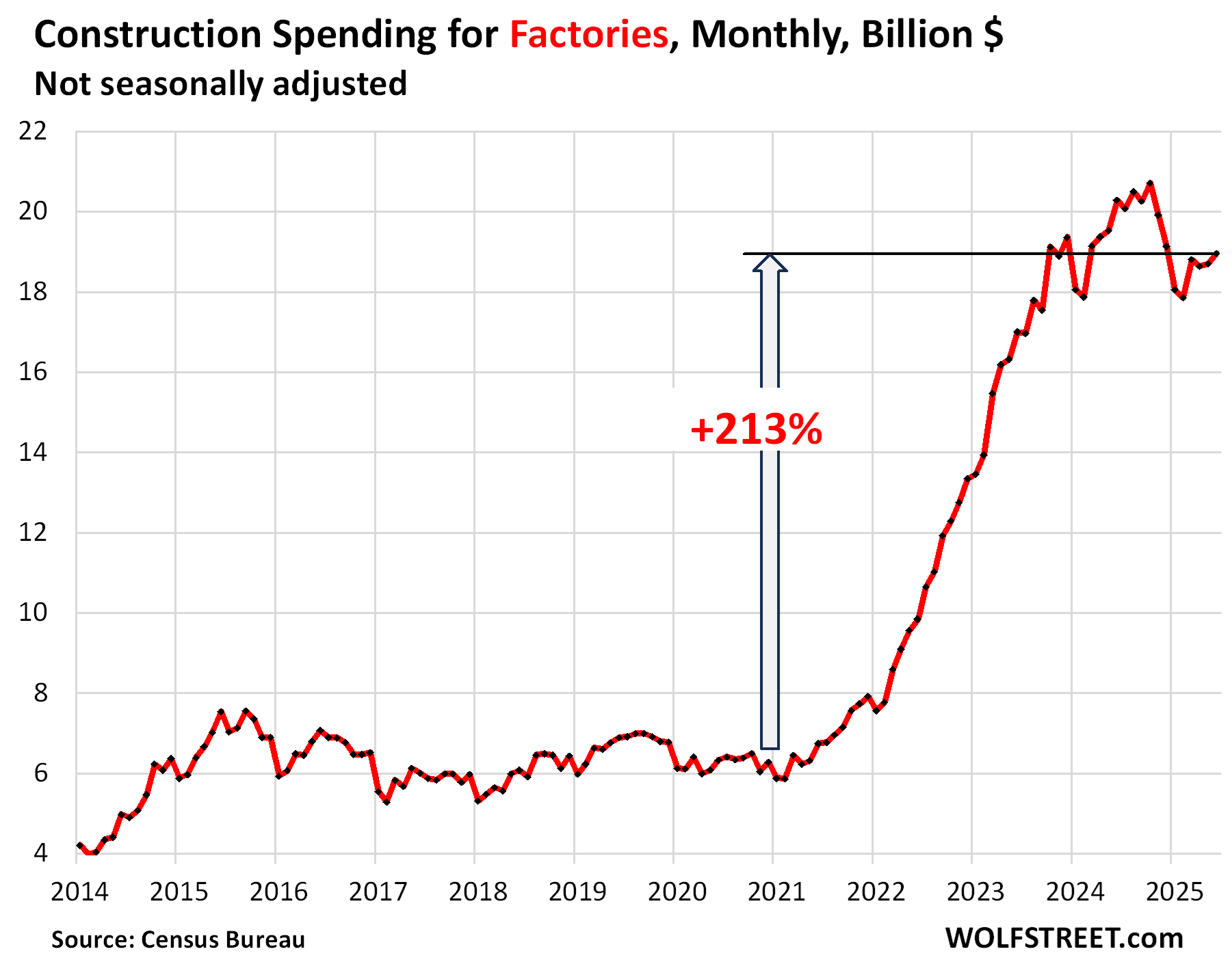Boeing & jet engine makers are part of it. And the other part is the rest of manufacturing.
By Wolf Richter for WOLF STREET.
Something interesting has been happening with orders that manufacturers in the US have received this year.
When Boeing gets an order for 30 planes in one month, it’s such a huge dollar amount that it moves the national durable goods orders for that month. Then the next month or two, Boeing doesn’t receive any big orders, just smaller orders and so overall orders drop for those months.
Orders for “Nondefense aircraft and parts” had spiked in May, but then plunged in June and July. These are orders received by Boeing’s civilian aircraft business, other aircraft manufacturers, jet engine makers, etc. This caused the overall durable goods orders to spike in May and then sink back to earth in June and July, but not all the way (blue in the chart).
Overall durable goods orders are a measure for demand for USA-made planes, trains, automobiles, trucks, motorcycles, snowmobiles, ATVs, ships, boats, fabricated metal products, machinery, computer and electronic products, electrical equipment, appliances, components, semiconductors, etc.
The three-month average (red in the chart), which irons out some of these month-to-month ups and downs, rose to a new record in July of $319.5 billion, up by 11.3% year-over-year, according to data from the Census Bureau today.
There had been a cooling-off period from mid-2023 off the pandemic’s massive surge, through early 2024. Then orders recovered a little for the rest of 2024.
But so far this year, orders have shot higher. Over the past six months, the three-month average jumped by 10.2% (+21.4% annualized). This is a big six-month move.

Defense accounted for only 6% of total durable goods orders over the past 12 months. It runs at about $13-22 billion a month and is not a huge factor in US manufacturing.
And more aircraft orders are coming: Korean Air announced yesterday that it had ordered 103 Boeing aircraft for $36.5 billion, plus GE Aerospace engines and services for another $13.7 billion, for a total of $50 billion.
Korean Air’s orders were not included in the July durable goods orders for “Nondefense aircraft and parts,” released today. Part of those orders may be included in the August or September data. So the up-and-down dance continues with another spike on the way.
In May, orders for nondefense aircraft and parts had spiked to $60 billion. In June, they dropped to $28 billion; and in July, to $19 billion. But now there’s Korean Air’s order making its way toward the data.

Durable goods orders without “Nondefense aircraft and parts” rose to $284 billion, roughly matching the record in May (blue in the chart below).
The three-month average (red) rose to $284 billion as well, a new record. Over the past six months, it rose by 2.8% (+5.7% annualized).
This is the rest of US manufacturing without nondefense aircraft and parts. Note the lull in 2023 through early 2024, the increase that followed, and the accelerated pace of increases over the past few months:

Shifting more manufacturing to the US is crucial. Trump and Biden both understood this. Trump 1 went for it with tariffs to incentivize companies to build factories in the US. Biden went for it with massive grants paid to companies under the CHIPS Act and other programs and acts to incentivize them to build factories in the US. Trump 2 went for it by imposing wide-ranging tariffs on imported goods to incentivize companies to produce in the US. In addition, he maintained the CHIPS Act, but rebranded it and got Intel to issue shares to the government in exchange for the $11 billion in cash it is receiving under the CHIPS Act.
It takes years to build a modern factory, to go from planning to mass-production. A factory construction boom started in mid-2021 and continues. The spending on the construction of factory buildings has been running at over triple the rate before the pandemic.
And this is just spending on the buildings and doesn’t include the costs of production equipment and industrial robots that can dwarf the costs of the building.

Enjoy reading WOLF STREET and want to support it? You can donate. I appreciate it immensely. Click on the mug to find out how:
![]()


Big numbers
Thanks Wolf
Not sure what font size has to do with anything!
We should have pandemics more often…. Just when everyone thought the world was going to end turned into the golden era of all history.
Doubt this one ages very well
Yes, and one wonders whether the data are inflation-adjusted (I could not find any mention of this in the text/ graphs).
Only morons adjust goods prices between companies with consumer price inflation that is dominated by consumer services, such as rent, insurance, and healthcare.
If you want to adjust anything, you adjust the prices of the specific goods sold by the price changes of those specific goods sold. Everything is braindead idiocy, and people who promote that are card-carrying morons.
I have said this a thousand times here at least. I now just delete this BS so I don’t have to waste any more time on it.
Or print a ton of money in a short while?
It’s amazing what $9 trillion of borrowing pumped into an economy will do. Now we just have to pay it back… right?
Nope. We cut taxes!
Greg P wrote: “It’s amazing what $9 trillion of borrowing pumped into an economy will do. Now we just have to pay it back… right?”
That money seems to have found its way into the bank accounts of a limited number of people. Why not tax it back from them ?
Greg P, what does this “pay it back” mean? Those are strange and unfamiliar words.
Or both
I wouldn’t call 20% inflation in four years a success. Working folks and investors in bonds lost a ton.
The bulk of stock gains is attributable to p/e expansion, which is not repeatable.
Not repeatable, but reversible…
Yes. As I mentioned in another thread, people think we recovered very well from the pandemic and its response, but in reality, all we did is confiscate 25% of the value of dollars held around the world. If that amount represented stored savings, it was stolen to pay for the government overreach. I don’t see that as a success or a model to use going forward.
Wolf, are data centers included in the factory construction spending data? If so, is it possible to break out what % share they are? There sure is a lot of tech company CapEx flying around to build those things so I’m curious what impact they are having in the big picture. Thanks.
No, data centers are a subcategory of office construction. But Census has broken out the data center data from office.
https://wolfstreet.com/2025/08/04/construction-spending-on-data-centers-office-buildings-and-electric-power-installations/
The index when you take out defense orders is all over the place. The Pentagon is such a huge buyer — far far too big — that durable goods orders may be a better proxy for Lockheed Martin and Raytheon than US mfg in general. And even though we’re going bankrupt the spigot of cash flowing to LMH and RTX will be the last to be shut off.
BS. Defense is 6% of total. RTGDFA.
Paragraph under the #1 chart:
“Defense accounted for only 6% of total durable goods orders over the past 12 months. It runs at about $13-22 billion a month and is not a huge factor in US manufacturing.“
MAGA certainly seems to be working, a very difficult thing for the doomsayers to accept. America is the only country in the world to be producing numbers like that, apart from some eastern nonentites reporting dubious figures. Socialist Germany? Down, down, down, a huge change from previously being industrial leaders. The rest of Europe? Even worse. Viva Capitalism, Viva.
A lot of people describe me as MAGA, but I don’t see our current economy as a success story. I see it as a testament to our ability to leverage the fact that the U.S. Dollar is the world’s reserve currency, and that we can consequently borrow trillions every year without causing runaway inflation.
We need to get our fiscal house in order if we want this to be sustainable.
And who said we are going into recession? Stagflation anybody, try booming inflation. Whoopie!
If Covid taught us anything, China held us hostage for all the products they produce for American companies. 3M facial mask, baby food, the works. NAFTA sold out the US American workers nearly 30 years ago. Congress no longer wanted a thriving middle class in America. Now we are in the Era of Millenial and Gen Z living in at home with baby boomer parents and grandparents, even as some who are trying to grasp the dream must still be supplemented with $1500 to $2000 a month to just survive. China has Trump on his knees begging magnets. How did we ever get so far gone down the rabbit hole with our number 1 enemy and sabotager. A communist country controlling America’s supply chain. Don’t even get me started on food, I’m all wet.
I was a little disappointed to discover my new Honda motorcycle is made in Thailand, unlike my car which came from Honda’s Ohio plant.
No complaints about the bike’s quality, but would be cool to see Honda powersports manufacture domestically.
Honda used to manufacture the Goldwing in its Maryville, Ohio plant but moved production back to Japan a decade or go. Thailand for some reason is a hot spot for motorcycle production. Harley-Davidson is supposedly moving the production of the Nightster to Thailand.
I doubt the current Goldwings are made in Japan although it would be cool if they were. Actual Japanese Hondas are rare.
Honda also makes most of their low(er) output gennys in Thailand. Probably a popular spot to manufacture small engines in general.
Good questions. Trump one policy era looks fairly flat. Be interesting to see the construction graph starting in 1960. The heyday maga believes in. Which, ironically, had much higher tax rates on the wealthy.
Kent, et al.- S/SE/E Asia are currently seen demographically by the motorcycle manufacturers as their growing future markets, N.America/Europe as long-matured ones…
may we all find a better day.
Isn’t my Mitzibushi Mirage made in Thailand? According to the manufacturer’s ID it is.
Your Mirage is also basically a motorcycle engine in a full-size car.
The current Kawasaki Ninja motorcycle engine has about the same horsepower as the Porsche 911 Turbo that came out when I was in High School in the 70’s.
3000gt was the stuff in the 90s! Used to drool on them in the dealer lot.
Building real things requires real inputs, specifically, refined commodities (of numerous types) and lots and lots of POWER (watts, joules, calories, etc). Data centers are sucking up a lot of power and water, although exactly what we are getting in return remains a mystery.
Regardless, sell the gains in tech (AI) and start buying the dividend-paying and promising companies that are providing those commodities and power!
Possible to know what % of Biden-era factory spending was related to green energy and what % was the delayed result of Trump 1 policy?
Wolf,
Thank you for the analysis.
Is there any way to track this to the reports about backlogs? So far, what I find appears to be of questionable validity, and a bit mangled perspectives.
New orders go INTO the backlog. They’re not fed by backlogs. Backlogs rise when the pace of production cannot keep up with the pace of new orders. That’s a good thing. Rising backlogs lead eventually to investment, expansion projects, and jobs.
Backlogs have been rising.
Thank you!
That’s exactly what I thought a backlog total would show, but I couldn’t find reliable data on it.
That seems to be very solid economic news!